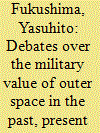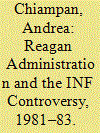|
|
|
Sort Order |
|
|
|
Items / Page
|
|
|
|
|
|
|
| Srl | Item |
| 1 |
ID:
128976


|
|
|
|
|
| Publication |
2013.
|
| Summary/Abstract |
Throughout the Cold War era, U.S. debate over the military value of outer space focused on how space
systems were able to contribute to nuclear deterrence and strategic stability between the U.S. and
Soviet Union. Sanctuary school was the first prevailing view of the debate, and it recognized the value
of outer space in the observation of regions within the boundaries of other sovereign nations. However,
the views of this school were relativized following the inauguration of the Reagan Administration.
As an alternative to the sanctuary school, there was another argument that made headway, which
was that outer space should be positioned as the ultimate high ground and that ballistic missiles
should be intercepted from outer space. Furthermore, following an increase in the military value of
outer space, the idea that space control would become a prerequisite for the utilization of outer space
began to draw interest. In the post-Cold War era, in contrast, the main point of contention has been
about how space systems can contribute to wartime military engagements. The Gulf War saw a rise
in the military value of space systems in terms of C4ISR, and since then the U.S. has maintained its
policy of pursuing the C4ISR value of space systems in military operations. At the same time, as the
perceived value of space systems increased, the view that space control should be established gained
traction. However, when considering the future path of the debate, space control has a number of
issues in terms of feasibility. Additionally, in the long term, the utilization of outer space as the high
ground may become the point of contention. Nonetheless, technical challenges and other issues must
be overcome before space-based BMD systems and other alternatives can be deployed.
|
|
|
|
|
|
|
|
|
|
|
|
|
|
|
|
| 2 |
ID:
174951


|
|
|
|
|
| Summary/Abstract |
In the fall of 1983, the international tension that characterized the Cold War reached new heights. Since the election of President Ronald W. Reagan, Soviet and American leaders had not yet held a summit meeting amid reciprocal accusations. In September, the Soviets shot down a commercial airline flight (KAL 007) that had strayed off course over Soviet airspace killing 269 people, including Congressman Larry McDonald (D-GA).1 In November, the North Atlantic Treaty Organization (NATO) military exercise codenamed “Able Archer” allegedly induced the Soviets to believe that war was imminent. This was perhaps an exaggeration, but in the aftermath of what came to be called the “war scare” many U.S. officials were persuaded that the world had—like in October 1962—come again close to a nuclear confrontation.2 The anti nuclear movement that had gathered unprecedented popular support throughout Western Europe and the United States did not need “Able Archer” to be reminded of the ever-present specter of a nuclear holocaust so graphically depicted in the iconic 1983 film The Day After.
|
|
|
|
|
|
|
|
|
|
|
|
|
|
|
|
|
|
|
|
|